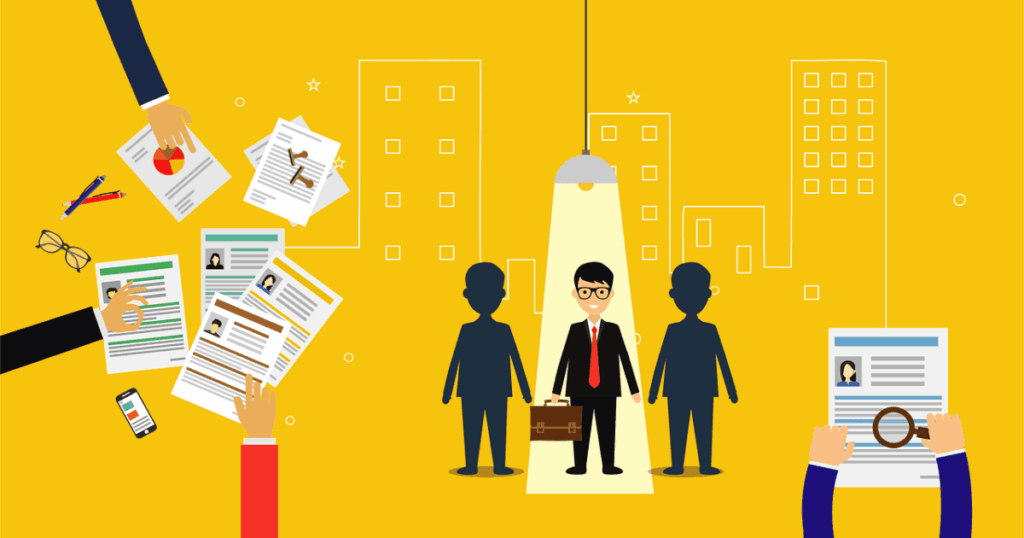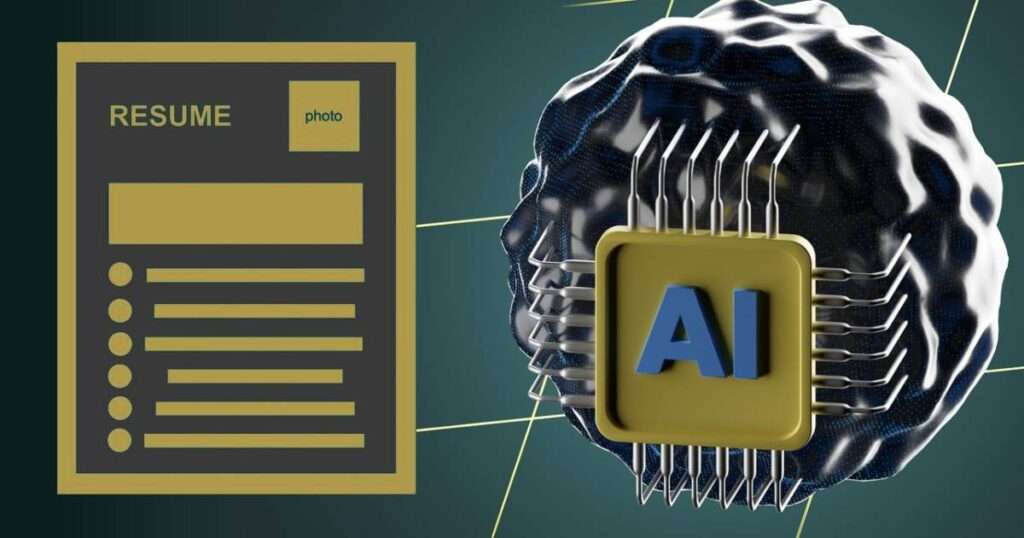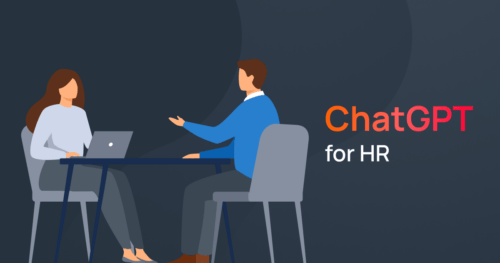ChatGPT and HR: An Introduction for HR Professionals
ChatGPT has been making waves recently, and rightly so, as a generative AI model, it offers immense potential. Its ability to rapidly generate content is being leveraged across numerous industries, and ChatGPT’s application in HR (human resources) departments has proved particularly beneficial. While AI tools are often seen as novel, they quickly become indispensable in business.
In HR, for instance, ChatGPT can enhance employee experience and efficiency by automating routine administrative tasks. To fully appreciate its impact, let’s first explore what ChatGPT is and how it operates in HR.
What is ChatGPT?
According to the glossary of AI Terms, GPT is a language model, powered by artificial intelligence, natural language processing (NLP) that provides context-specific, humanlike responses to user prompts. However, it’s not like a traditional chatbot. For example, basic chatbots only respond with a few words – and you’re lucky if the content is relevant to your query.
ChatGPT, created by OpenAI, can respond to prompts with paragraphs of relevant and personalized content. Its output includes bulleted and numbered lists when appropriate, enhancing the clarity and effectiveness of its responses to questions. However, users may encounter inaccurate data or responses, so it is important to critically evaluate the information provided.
The difference is that Generative AI is trained to recognize natural language in context and understand the nuance of a prompt. Traditional chatbots only pick up on keywords and phrases, so they don’t always capture the full meaning of the input.
This is why responses often lack relevance and usefulness. GPT models are revolutionizing this experience by bringing a higher degree of relevance to chatbot queries across various domains and industries. One such example is ChatGPT in HR, which we will discuss in this article.
Use Cases of Generative AI and ChatGPT for HR Professionals
In the fast-evolving HR landscape, ChatGPT for HR is ushering in a new era of efficiency and innovation. This powerful tool streamlines tasks from crafting precise job descriptions to automating candidate screening and filtering through large volumes of candidates.
It also plays a pivotal role in enhancing employee experiences, from onboarding to mental health support. ChatGPT can provide personalized responses in various HR contexts, such as candidate engagement and employee communications. By integrating ChatGPT, HR departments can shift their focus towards more strategic activities, significantly improving operational workflows and employee satisfaction.
Let’s explore the transformative impact of ChatGPT across various HR functions.
- Generate job posting descriptions that encompass key responsibilities for the role
- Screening resumes of job candidates in the recruiting process
- Drafting interview questions
- Enabling hiring decisions for getting the top talent on board
- Determining salary range for potential candidates with competitive pay
- Leveraging ChatGPT to create training materials for new hires
- Conduct performance reviews based on skills and looking at data
- Focus on strategic activities in HR and automate administrative tasks
- Improve the overall candidate experience for new employees in the organization
- Improve employee mental health by providing relevant resources and training materials
- Enable employee self-service, answer employee questions, sending reminders on new and existing company policies

7 Benefits of Generative AI and ChatGPT for Human Resources
1. Crafting Job Descriptions Easily
Job postings are a repetitive process that can be automated to a large degree. Normally, HR departments have recruiters or hiring managers write job descriptions, but this is something ChatGPT can do instead.
With a well-written prompt, you can automate content creation and generate a first draft of competency and technical skills definitions, job descriptions, and any other content needed for a job listing. Once you have the draft, it can be easily edited to meet your needs.
Specific and clear prompts are the key to getting good results from ChatGPT. For example, don’t just say, “Write a job description for [insert role here].” This will get you a generic response that will be lacking. Instead, get specific:
“Write a job description for a CISSP-certified Chief Information Security Officer located in Manhattan, NY, including a list of job responsibilities and required competencies.”
When you get specific with prompts, you’ll get more detailed results that you won’t have to work as hard to edit. Including details in your job descriptions ensures that the AI generates more relevant and tailored content, enhancing the effectiveness of your communication.
2. Use ChatGPT for Research in HR
One of the more interesting ways you can use ChatGPT is to research things like average salaries for positions and medical benefits sharing ratios. Professional survey providers are still more accurate at this time, but this will likely change in the future.
Since salary transparency is starting to be required all over, the responses from ChatGPT regarding salary and employee benefits will become more accurate with time. This is great news for startups that don’t have a budget for benchmarking data.
3. Generate Pre-Screening Questions
When it comes to sourcing, pre-screening, and scheduling interviews, you’re in for a time-consuming task. ChatGPT creates opportunities for efficiency and time-saving by generating prescreen questions. In the future, you may be able to have candidates interact directly with a Generative AI chatbot to complete a live screening interview or test. With the right training, ChatGPT can theoretically administer interviews and tests and rate candidate responses automatically.
Automating as much of the hiring and recruitment process as possible helps you make better decisions. You’ll have more time to prioritize candidates and help out your human resources and interviewers, so they can spend more time assessing potential talent.
4. Create Content for your Internal Help Desk
Every business needs an internal help desk for employees. Throughout the day, and over time, workers will have questions and needs that will otherwise go unaddressed. Teams need a company resource they can access to get information and answers to pressing questions, especially when they’re new.
Team members who have just been hired will lean heavily on co-workers for a while, which doesn’t seem like a big deal at first glance. However, this puts a burden on your team and will slow them down. A help desk will relieve this burden and reduce the number of direct calls your department receives. Accountability in the development and implementation of company policies ensures that employees have clear guidelines and expectations for conduct.
A help desk for employees should be a standard resource provided by your HR department. At the very least, this should include a database full of self-help articles loaded into a user-friendly, searchable knowledge base. On top of that, your help desk should have an AI chatbot that provides users with relevant answers and links to self-help knowledge base content.
Will employees use an internal help desk? Absolutely. Most people prefer self-help options over making a live phone call, which is good news for your HR department. Self-help resources increase the auto-resolution of support requests.
You don’t have time to field a bunch of calls from employees whose problems can be resolved quickly and easily through articles. Don’t have time to write them? No problem. That’s where ChatGPT comes into play.
– Have ChatGPT write your knowledge base articles
Before you can launch a help desk automation, you need to have a sufficient amount of knowledge base articles written. This is where ChatGPT can help. With some well-written prompts, you can generate articles for common issues along with detailed troubleshooting guides. The content will need to be reviewed and edited, but you’ll already have a good portion of the work done. You can also enroll in a free ChatGPT for HR course to learn how to effectively use these tools, gaining lifetime access to course materials and a certificate of completion.
You can also script your chatbot responses using ChatGPT. Once you have some basic responses, review them for accuracy and add any necessary specifics. You can always refine and optimize your automated responses over time.
5. Enhance Performance Goals and Expectations
For companies that assess employee performance periodically, a Generative AI and ChatGPT can be useful for employee feedback and creating performance goal outlines and detailed expectations for various competencies.
Some of this information will be the same for multiple employees, so once you generate the template, it can be used for future reviews. The best part is you won’t have to do the work or hire it out.
If you don’t have time, leave this up to your hiring managers and ask them to use a Generative AI assistant, to identify trends and create outlines for performance assessments.
6. Write and Perfect Internal Documentation
To go one step further, an Enterprise HR copilot can be used to enhance competency guides, clarify career ladders, and create documentation to support managers who take an active role in improving employee performance.
Any type of content can be created or at least outlined using ChatGPT prompts. Why not use this amazing tool to help you create important internal documents? If you ever struggle with finding the right words, even for simple content, Generative AI can help.
7. Company Emails
When you need to make an announcement by email or share information throughout the company, ChatGPT can help. If the information is somewhat standard, like announcing a data breach or a change in the company policies, you might be able to get a good template outline using Generative AI. After the general outline is generated for you, it won’t take long to insert the specifics of your message.

Is ‘Prompt Engineering’ the Next Big Skill for HR?
ChatGPT seems like a plug-and-play solution but unlocking its full potential requires a strategic approach called ‘prompt engineering’. This is designing questions or instructions that guide the AI to give accurate and contextually relevant answers. As businesses start to adopt AI tools some organizations are even hiring roles like ‘ChatGPT Specialists’ and ‘Prompt Engineers’ to get the most out of AI interactions.
For example, Boston Children’s Hospital recently hired an AI Prompt Engineer to create and refine prompts, troubleshoot technical issues, and ensure outputs were reliable. Freelance platforms like Upwork have roles with similar responsibilities and competitive rates.
But according to Wharton School professor Ethan Mollick, these roles will be short-lived. AI is moving fast and as models improve they require less human input to give precise and user-friendly results.
That doesn’t mean prompt engineering is dead – it’s still a valuable skill for now. A well-crafted prompt can make the difference between a generic response and one that’s tailored to you. For example, HR professionals can start with broad prompts and refine them with follow-up questions to get outputs that resonate with their audience.
How HR Professionals Can Use ChatGPT
Here are some examples of prompts HR professionals can use to get work done and add value:
- Job Descriptions Prompt: “Write a job description for an HR Generalist, what are the key responsibilities, qualifications and benefits?” Follow up: “Summarise this into a short LinkedIn post”
- Candidate Interviews Prompt: “Generate a list of behavioral interview questions for a mid career HR professional with 5 years experience” Follow up: “Conflict resolution and leadership”
- Employee Communication Prompt: “Write a memo to a mid level manager about tardiness. What are the expectations and next steps?” Follow up: “Rewrite this with a more empathetic tone but still professional”
- Compensation Insights Prompt: “What is the salary range for HR Generalists in New York City with 5 years of experience?” Follow up: “Include certifications or current market trends”
- Training Simulations Prompt: “I will ask you interview questions for a Senior HR Manager role and you respond as the candidate.” Follow up: “Give detailed answers, focus on strategic HR management.”
What does Generative AI Offer to HR Professionals?
While ChatGPT has only been around since November 2022, Generative AI is not a new concept. So, what’s the big deal?
Through ChatGPT, Generative AI is facilitating the next step in business automation, Including Generative AI for the IT department, human resources, and customer service. According to IBM’s Global AI Adoption Index report from 2022, 35% of businesses already use AI, which was a four-point increase from 2021. However, ChatGPT is changing the way companies use automation in their HR processes.
When it comes to HR departments, businesses want to automate repetitive tasks and processes to increase efficiency and responsiveness and create better employee experiences. These are all good reasons to use ChatGPT in your HR department to enhance productivity.
Don’t worry – AI isn’t going to replace real humans in your HR department. It will, however, support your HR team.
Conclusion: ChatGPT isn’t Perfect, but it’s a Good Starting Point
Generative AI tools, such as ChatGPT can speed up tasks and give you valuable insights but every output should be human-reviewed. Adjustments are often needed to get the AI’s responses to match your organization’s tone, strategy, and specific needs. As AI tools evolve prompt engineering may become less relevant but for now, it’s a key skill to get the most out of generative AI in HR.
Using the best generative AI platform can potentially save money and increase effectiveness for a company. People expect the output from these platforms to be reliable to trust the technology. We aren’t there yet, but that’s acceptable, provided HR leaders are aware of these limitations and meticulously review AI-generated content for accuracy.
Based on current results, it won’t take long for Generative AI to become an essential tool for HR departments. You can get ahead of the game by testing it out now for simple purposes. By the time it becomes a standard tool, you’ll already be familiar with it and know how to create prompts and tasks that get ideal results.
If you’re already using an internal help desk, try using ChatGPT to create some of your knowledge-base articles. If you don’t have a help desk yet, we offer an enterprise AI service desk and AI Copilot for HR departments. To learn more, contact us or schedule your free AI demo today!

